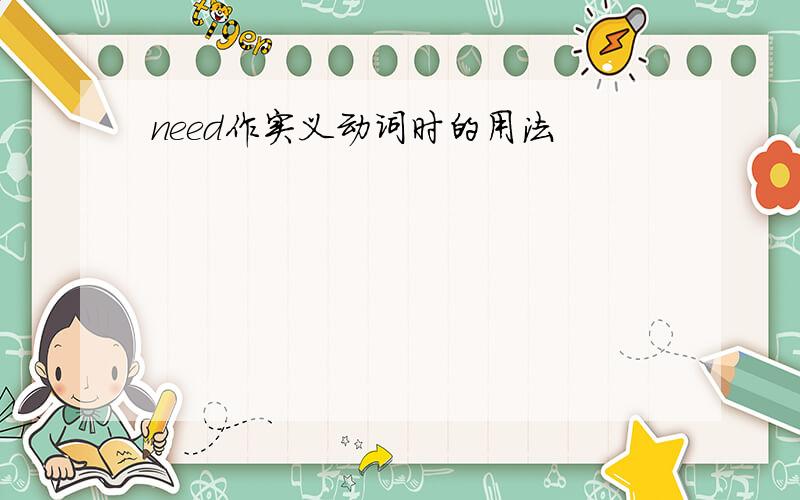need作实义动词时的用法
来源:学生作业帮 编辑:神马作文网作业帮 分类:英语作业 时间:2024/11/14 10:54:13
need作实义动词时的用法

need用法解析
need一词是中学英语“四会”(听、说、读、写)词汇之一,能够充分理解和正确运用它是教学大纲的必然要求.但由于其词性多变,许多学生对它满怀疑惑,特别是在需要将句子变为否定与疑问的时候不知是在其后加not呢,还是借助助动词.
虽然need一词的汉语意思都与“需要”有关,但就词性而言,它可用作实义动词、情态动词和名词;词性发生了变化,它的用法与在句子中所起的作用也随之改变.
一.用作实义动词
作为实义动词,need后面的宾语可以是名词、动名词、动词不定式或代词,这种情况下,need既可用于肯定句,也可用于否定句和疑问句,构成否定句和疑问句时要借助于助动词do或does.
1.need sth.
这是need最常见的用法之一,其后的宾语可以是名词,也可以是代词.如:
1). We need a great deal of money now. 我们需要和多钱.
2). They don’t it any more. 他们不再需要它了.
3). Does your father need any help? 你爸爸需要帮助吗?
2.need doing 与 need to be done
need后面可跟动名词作宾语,这种情况下应注意两点:
①.主动形式的动名词doing具有被动的含义;
②.该动名词可以改为其动词不定式的被动形式而句子的意义不变.例如:
4). The door needs painting.
= The door needs to be painted. 那扇门需要油漆一下.
5). Your car needs mending.
= Your car needs to be repaired. 你的车需要维修了.
3.need to do sth.
作为实义动词,need后面需要接带to的动词不定式,表示有义务或责任去做某事.如:
6). What do we need to take for the picnic? 野餐我们需要带些什么?
7). Will we need to show our passports? 我们需要出示护照吗?
8). You need to take good care of your mother. 你要好好照料你妈妈.
二.用作情态动词
作为情态动词的need具有情态动词的一般性质,要充分阐释作为情态动词的need的用法,务必首先说明白情态动词的特征.情态动词的主要特征:
①.没有人称和数的变化.不论主语是第几人称,不论主语是单数还是复数,情态都词都无形式变化;
②.不能单独充当谓语.情态动词必须与一个实义动词一起构成复合谓语,并且这个实意动词要始终是动词原形.
③.变为否定句时只需在情态动词之后加not.
④.变为疑问句时只需将情态动词提到主语的前面.
这是情态动词的共性,作为情态动词的need当然也具有这些共性.了解了这些还不够,还要掌握作为情态动词need的一个个性,就是它只能用于否定句和疑问句,或用于由if或whether引导的宾语从句中,一般不能用于肯定句.理解了这些之后,我们便可以如此区分need的词性了:只要need后面跟的是动词原形,它就是情态动词.这时,变否定,只需在其后加not;变为疑问句,只需把它移主语的前面.例如:
9). Need I type this letter again? 我需要重新录入将这封信吗?
10). There is enough time. You needn’t hurry. 有的是时间,你不必着急.
11). The president wondered whether he need send more soldiers. 总统不知道他是否要增兵.
12). ---Must I hand in my homework now? 现在我必须交作业吗?
---No, you needn’t. 不,你不必.
三.用作名词
need作为名词,含义为“缺乏,需要”;其复数表示“基本需要”.要掌握两个词组:in (great) need of(急需) 与meet the needs of(满足……的需要).例如:
13). There’s no need for you to try again. 你不必再尝试了.
14). The factory is in great need of funds. 那家工厂急需资金.
15). This house of the 1790’s can even meet the needs of the 21st century. 这栋18世纪90年代的房子甚至能够满足21世纪的需要.
四.自我检测
现在可能你很想知道你是否完全掌握了need的用法,请做下列练习,进行一次自我检测,将正确答案填写在题前的括号中.
( ) 1. You any help, do you?
A. don’t need B. needn’t C. need D. doesn’t need
( ) 2. ---Must I stay at the office this afternoon? ---No, you .
A. don’t B. needn’t C. don’t need D. can’t
( ) 3. Tom get up a little earlier tomorrow.
A. needs B. need C. need to D. needs to
( ) 4. Need the doctor ________ with you tonight?
A. staying B. stay C. stays D. to stay
( ) 5. Look! Your shirt is so dirty. It .
A. need washing B. need to wash C. needs washing D. need wash
( ) 6. The supply can’t the demand.
A. meet need of B. meet the need of
C. meet the needs of D. meet needs of
( ).7. The hospital is blood.
A. in great need of B. on great need of
C. in great need with D. on great need with
( ) 8. Your room is full of dust. It .
A. need clean B. need cleaning
C. need to be cleaned D. needs to be cleaned
( ) 9. David anything to drink?
A. Need,…\ B. Needs,…\ C. Does…need D. Do…need
( ) 10. You to the meeting tomorrow if you have something important to do.
A. needn’t to come B. don’t need come
C. don’t need coming D. needn’t come
KEY: 1-5. ABDBC 6-10. CADCD
need一词是中学英语“四会”(听、说、读、写)词汇之一,能够充分理解和正确运用它是教学大纲的必然要求.但由于其词性多变,许多学生对它满怀疑惑,特别是在需要将句子变为否定与疑问的时候不知是在其后加not呢,还是借助助动词.
虽然need一词的汉语意思都与“需要”有关,但就词性而言,它可用作实义动词、情态动词和名词;词性发生了变化,它的用法与在句子中所起的作用也随之改变.
一.用作实义动词
作为实义动词,need后面的宾语可以是名词、动名词、动词不定式或代词,这种情况下,need既可用于肯定句,也可用于否定句和疑问句,构成否定句和疑问句时要借助于助动词do或does.
1.need sth.
这是need最常见的用法之一,其后的宾语可以是名词,也可以是代词.如:
1). We need a great deal of money now. 我们需要和多钱.
2). They don’t it any more. 他们不再需要它了.
3). Does your father need any help? 你爸爸需要帮助吗?
2.need doing 与 need to be done
need后面可跟动名词作宾语,这种情况下应注意两点:
①.主动形式的动名词doing具有被动的含义;
②.该动名词可以改为其动词不定式的被动形式而句子的意义不变.例如:
4). The door needs painting.
= The door needs to be painted. 那扇门需要油漆一下.
5). Your car needs mending.
= Your car needs to be repaired. 你的车需要维修了.
3.need to do sth.
作为实义动词,need后面需要接带to的动词不定式,表示有义务或责任去做某事.如:
6). What do we need to take for the picnic? 野餐我们需要带些什么?
7). Will we need to show our passports? 我们需要出示护照吗?
8). You need to take good care of your mother. 你要好好照料你妈妈.
二.用作情态动词
作为情态动词的need具有情态动词的一般性质,要充分阐释作为情态动词的need的用法,务必首先说明白情态动词的特征.情态动词的主要特征:
①.没有人称和数的变化.不论主语是第几人称,不论主语是单数还是复数,情态都词都无形式变化;
②.不能单独充当谓语.情态动词必须与一个实义动词一起构成复合谓语,并且这个实意动词要始终是动词原形.
③.变为否定句时只需在情态动词之后加not.
④.变为疑问句时只需将情态动词提到主语的前面.
这是情态动词的共性,作为情态动词的need当然也具有这些共性.了解了这些还不够,还要掌握作为情态动词need的一个个性,就是它只能用于否定句和疑问句,或用于由if或whether引导的宾语从句中,一般不能用于肯定句.理解了这些之后,我们便可以如此区分need的词性了:只要need后面跟的是动词原形,它就是情态动词.这时,变否定,只需在其后加not;变为疑问句,只需把它移主语的前面.例如:
9). Need I type this letter again? 我需要重新录入将这封信吗?
10). There is enough time. You needn’t hurry. 有的是时间,你不必着急.
11). The president wondered whether he need send more soldiers. 总统不知道他是否要增兵.
12). ---Must I hand in my homework now? 现在我必须交作业吗?
---No, you needn’t. 不,你不必.
三.用作名词
need作为名词,含义为“缺乏,需要”;其复数表示“基本需要”.要掌握两个词组:in (great) need of(急需) 与meet the needs of(满足……的需要).例如:
13). There’s no need for you to try again. 你不必再尝试了.
14). The factory is in great need of funds. 那家工厂急需资金.
15). This house of the 1790’s can even meet the needs of the 21st century. 这栋18世纪90年代的房子甚至能够满足21世纪的需要.
四.自我检测
现在可能你很想知道你是否完全掌握了need的用法,请做下列练习,进行一次自我检测,将正确答案填写在题前的括号中.
( ) 1. You any help, do you?
A. don’t need B. needn’t C. need D. doesn’t need
( ) 2. ---Must I stay at the office this afternoon? ---No, you .
A. don’t B. needn’t C. don’t need D. can’t
( ) 3. Tom get up a little earlier tomorrow.
A. needs B. need C. need to D. needs to
( ) 4. Need the doctor ________ with you tonight?
A. staying B. stay C. stays D. to stay
( ) 5. Look! Your shirt is so dirty. It .
A. need washing B. need to wash C. needs washing D. need wash
( ) 6. The supply can’t the demand.
A. meet need of B. meet the need of
C. meet the needs of D. meet needs of
( ).7. The hospital is blood.
A. in great need of B. on great need of
C. in great need with D. on great need with
( ) 8. Your room is full of dust. It .
A. need clean B. need cleaning
C. need to be cleaned D. needs to be cleaned
( ) 9. David anything to drink?
A. Need,…\ B. Needs,…\ C. Does…need D. Do…need
( ) 10. You to the meeting tomorrow if you have something important to do.
A. needn’t to come B. don’t need come
C. don’t need coming D. needn’t come
KEY: 1-5. ABDBC 6-10. CADCD